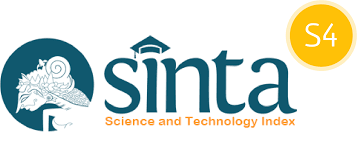Identifikasi Serotipe dan Sensitivitas Antibiotik S. pneumoniae yang Dibawa Nasofaring Penderita Oma di Kabupaten Banyumas
Abstract
The aims of this study are to detect S. pneumoniae carried by nasopharnyx of children in primary school (aged 6-12 years) that diagnosed with AOM, to identify sensitivity of S. pneumoniae to antibiotics. The design of this study is nonexperimental survey with the descriptive analysis. Sampling was conducted in September - December 2018 in Banyumas district primary schools. Detection of S. pneumoniae was performed with microbiology methods. Meanwhile, serotype was determined by multiplex PCR and sensitivity to antibiotics was deduced using disc diffusion.
The result of this study showed that carriage rate of S. pneumoniae carried by nasopharynx in children aged over 5 years that diagnosed with AOM in the Banyumas district was 35%. Serotype of S. pneumoniae obtainend from this study were 6A/6B, 6C/6D, 17F, 3, 13, 14, 23B, and untypeable. In addition, isolates of S. pneumoniae were highly susceptible to clindamycin (100%), erythromycin (100%), sulphametaxazole/trimethoprim (100%), chloramphenicol (88%), oxacillin (77%), and tetracycline (66%).
References
Auranen, K., Rinta-Kokko, H., Goldblatt, D., Nohynek H., O'Brien, K. L. 2013. Colonisation endpoints in Streptococcus pneumoniae vaccine trials. Vaccine, 32: 153-158.
Bogaert, D., De Groot, R., Hermans, P. W. M. 2004. Strep¬tococcus pneumoniae colonisation: the key to pneumococcal disease. Lancet Infect Dis, 4: 144-1454.
Bosch, A. A., Biesbroek, G., Trzcinski, K., Sanders, E. A., Bogaert, D. 2013. Viral and bacterial interactions in the upper respiratory tract. PLoS Pathog, 9:e1003057.
Bridy-Pappas, A. E., Pharm, D., Margolis, M. B., Pharm, D., Center, K. J. M. D., Isaacman, D. J. M D. 2005. Streptococcus pneumoniae: Description of the pathogen disease epidemiology, treatment, and prevention. Pharmacotherapy, 25(9): 1193-1212.
Carvalho, M. D. G., Pimenta, F. C., Jackson, D., Roundtree, A., Ahmad, Y., Millar, E. V., Beall, B. W. 2010. Revisiting pneumococcal carriage by use of broth enrichment and PCR techniques for enhanced detection of carriage and serotypes. Journal of clinical microbiology, 48(5): 1611-1618.
CDC. 2015. Epidemiology and prevention of vaccine-preventable disease: Pneumococcal disease. USA: Centers for Disease Control and Prevention.
Dunne, E. M., Lupiwa, T., Montgomery, J. 2010. Streptococcus pneumoniae serogroups and colony morphology: a look back. Papua New Guinea Medical Journal, 53: 166-168.
Farida, H., Severin, J. A., Gasem M. H., Keuter, M., Wahyono, H.. 2014. Nasopharyngeal carriage of Streptococcus pneumoniae-prone age groups in Semarang, Java Island, Indonesia. PLoS ONE, 9.
Ferrandiz, M. J., De la Campa, A. G. 2002. The membrane-assosiated F0F1 ATPase is essential for the viability of Streptococcus pneumoniae. FEMS Microbiology Letters, 212: 133-138.
Hadinegoro, S.R., Prayitno, A., Khoer, M. M., Djelantik, I. G. G., Dewi, N. E., Indriyani, A. K., Muttaqin, Z., Safari, D. 2016. Nasopharyngeal carriage of Streptococcus pneumoniae in healthy children under five years old in central lombok regency, Indonesia. Southeast Asian J Trop Med Public Health, 3(3): 1-9.
Kadioglu, A., Weiser, J. N., Paton, J. C., Andrew, P. W. 2008. The Role of Streptococcus pneumoniae: Emergence and pathogenesis. mBio, 7(2): 1792-1815.
Keller, L. E., D. A. Robinson, L. S. McDaniel, L. S. 2016. Nonecapsulated Streptococcus pneumoniae: emergence and pathogenesis. American Society for Microbiology, 7(2): 1-12.
Korona-Glowniak, I., Zychowski, P., Siwiec, R., Mazur, E., Niedxielska, G., Malm, A. 2018. Resistant Streptococcus pneumoniae strains in children with acute otitis media-high risk of persistent colonization after treatment. BMC Infectious Disease, 18: 1-12.
Nonmark-Henriques, B., Toumanen, E. I., 2013. The pneumococcus: Epidemiology microbiology, and pathogenesis. Cold Spring Harb Perspect Med, 3:a010215.
Pikis, A., Campos, J. M., Rodriguez, W. J., Keith, J. M. 2001. Optochin resistance in Streptococcus pneumoniae: Mechanism, significance, and clinical implications. The Journal of Infectious Disease, 184: 582-590.
Pinti, M., Appay, V., Campisi, J., Frasca, D., Fulop, T., Sauce, D., Larbi, A., Weinberg, B., Cossarizza, A. 2016. Aging of the immune system-focus on inflammation and vaccination. European Journal of Immunology, 46: 2286–2301.
Satzke, C., Turner, P., Virolainen-Julkunen, A., Adrian, P. V., Antonio, M. 2013. Standard method for detecting uppers respiratory carriage of Streptococcus pneumoniae: Updated recommendations from the world health organization pneumococcal carriage working group. J. Vaccine, 32: 165-179.
Tam, S. S., Lee, C., Winter, R.E. 1993. Hemin utilization is related to virulence of Streptococcus
pneumoniae. American Society for Microbiology. 61(12): 5401-5405.














_copy.png)



